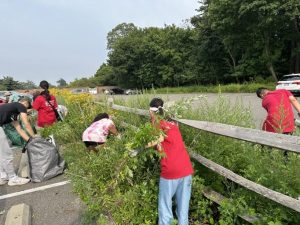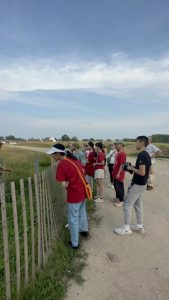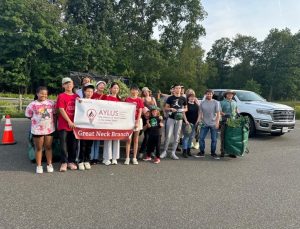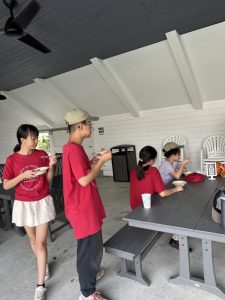On July 26, 2025, from 5 to 7 pm, Aylus Great neck volunteers went to Caumsett Park to remove invasive plants, primarily Mugwort which has been growing on the greenbelt next to the parking lot.
Prior to the event volunteers received guidance from the director. They learned about Mugwort and how to remove them. The volunteers were given protective gloves and began to remove the invasive plants. Mugworts range in all different sizes, the short ones are as short as a finger, and the long one can be as tall as 3 feet As the volunteers carefully cleared out the Mugwort , they put the waste into hemp bags. Finally, all the cleared Mugwort was dumped into a truck for disposal to make room for other native plants to grow. The volunteers and the volunteer coordinators collected a total of 365 pounds of Mugworts in the end, which was an amazing job!
Invasive species cause great damage to the local environment be reducing biodiversity and outcompeting other plants in the area. There are many reasons why they appear. The reason why they destroy and reduce the biodiversity of certain areas is that they usually have no natural enemies (because they are invasive species) and compete for the ecological niches of other species. While it may take a long time to remove these plants, but it is very meaningful. It is not only a good way to relax, but also a contribution to the environment.
After the volunteers cleared the invasive plants, the AYLUS volunteers took a break in the classroom, had ice cream, and visited the pollinator garden along Fisherman Road. The volunteers learned a lot of interesting facts, such as pollinators like some species of moths and butterflies liked to eat English plantains, Saint John’s worts, milkweed and sunflowers. Also, the pollinator garden was especially designed for a rare butterfly species called the Baltimore Checkerspot Butterfly. A huge area was designed to be planted English Plantains after the clearing up of invasive plants with very long roots using heat, which usually lasts for weeks. This is the area that is wished to be the place where the Baltimore Checkerspot Butterflies make nests and where its larvas feed themselves in the future. This was such a great volunteering experience to learn more about native species, the ecosystem, and how to protect it!
Volunteers who participated(2hrs): Yingxiang Liu, Felicia Liu ,Yuya Liu ,Yangzilin Hu,Sherry Xia ,Zachary Chen.
Reported by: Yingxiang Liu.




